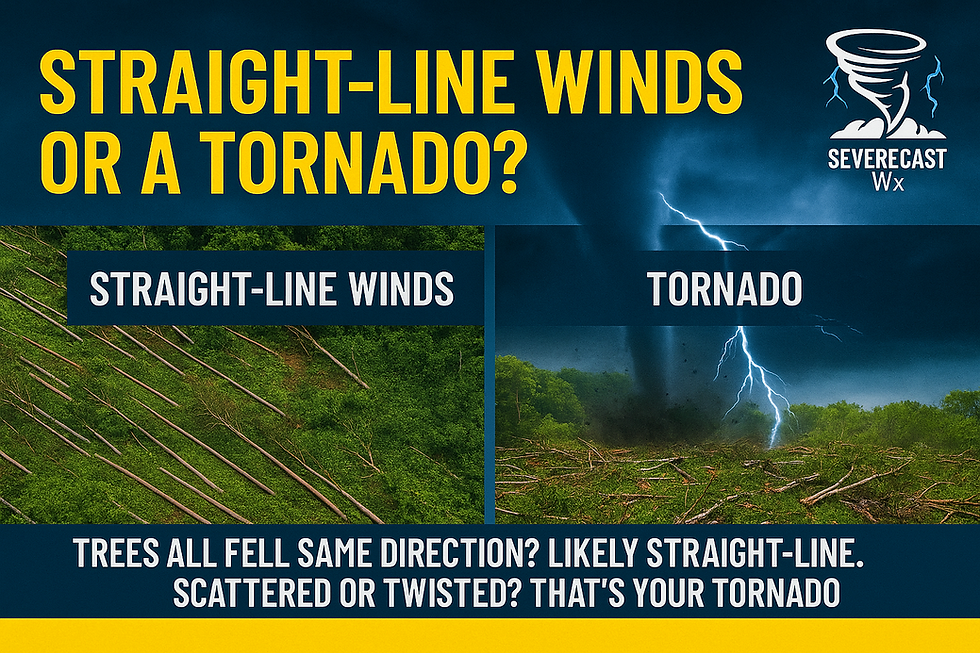Tornado Watch vs. Tornado Warning: What's the Difference?
- Nicole Carbone
- May 18
- 3 min read
Each year, tornadoes threaten lives and property across the United States, yet confusion still swirls around one of the most basic but critical distinctions in severe weather alerts: the difference between a tornado watch and a tornado warning. Even more confusion arises when the warnings are tagged as "Radar Indicated," "Observed," "PDS," or even a rare "Tornado Emergency." Let's break down in detail, because understanding the difference can literally save lives.

Tornado Watch: STAY ALERT
A Tornado Watch means conditions are favorable for tornadoes to form. It doesn't mean a tornado is happening, it means the environment is primed for development. Think of it like a "Tornado Ingredients Alert."
Who Issues Them?
The Storm Prediction Center (SPC).
What should you do?
Stay weather aware.
Have multiple ways to receive alerts (weather radio, apps, local TV).
Know where your safe place is and be ready to move quickly.
Example:
You're baking cookies. The ingredients are out on the counter to make the cookies, that's the watch. Nothing's in the oven yet, but you've got everything ready to go.
Tornado Warning: TAKE COVER NOW
A Tornado Warning means a tornado is occurring or imminent based on radar or visual confirmation.
Who Issues It?
Your local National Weather Service (NWS)
What should you do?
Immediately seek shelter in a basement or interior room away from windows
Treat every warning seriously, your life depends on it.
Types of Tornado Warnings: Not All Are Equal
Here's when things get more specific, and more urgent. Tornado warnings often carry tags that describe the confidence and severity of the situation.
Radar-Indicated Tornado Warning
What it means: Radar is showing signs of rotation (a mesocyclone or tornadic signature), but no confirmed tornado on the ground yet.
Confidence Level: Moderate
Takeaway: Take it seriously, it could become a confirmed tornado at any moment.
Tornado Observed Warning
What it means: A tornado has been visually spotted or confirmed by radar debris signature (known as a Tornado Debris Signature, or TDS).
Confidence Level: High
Takeaway: A tornado is on the ground, seek shelter immediately.
Particularly Dangerous Situation (PDS) Tornado
What it means: A confirmed tornado is expected to be long-lived, violent, and capable of causing major destruction.
Confidence Level: Very High
Takeaway: These are not put out for just ANY tornado. PDS is only used when there's strong confidence of a destructive tornado. These warnings should trigger immediate action without hesitation.
Tornado Emergency
What it means: A large, destructive tornado is on the ground, heading toward a populated area. Catastrophic damage and loss of life will happen if proper precautions are not taken.
Confidence Level: Extreme
Takeaway: This is the highest alert issued for a tornado. It's only used in the most dire situations like Joplin, MO (2011) or Moore, OK (2013). If you ever see this alert, act without delay.
Why People Confuse These Alerts
Many people don't fully understand the difference between a watch and a warning, or the specific warning tags because:
- Alerts sound similar or look identical on TV screens or phone notifications.
- There's a lack of public education on severe weather terminology.
- Social media sometimes shares warnings without context or explanation.
That's why the public outreach and meteorologist-led education is so important, and why platforms like SevereCast Wx exist: to break it down clearly and help you stay safe.
Understanding the nuances of tornado alerts helps eliminate confusion, reduce panic, and most importantly, save lives. Treat every warning with urgency, know your safe place, and stay weather aware.





Comments